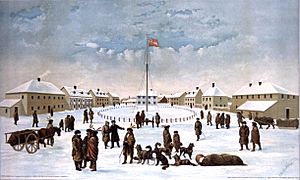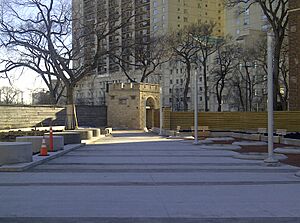Fort Garry facts for kids
Quick facts for kids Fort Garry |
|
|---|---|
| At the confluence of the Red and Assiniboine rivers in what is now downtown Winnipeg, Manitoba, Canada | |

Fort Garry in 1884
|
|
| Type | Hudson's Bay Company trading post |
| Site information | |
| Controlled by | Hudson's Bay Company Occupied by the Métis in 1869-70 |
| Website | UpperFortGarry.com |
| Site history | |
| Built | 1822 |
| Battles/wars | Red River Rebellion |
| Official name: Forts Rouge, Garry, and Gibraltar National Historic Site of Canada | |
| Designated: | 1924 |
Fort Garry, also known as Upper Fort Garry, was an important trading post. It was built by the Hudson's Bay Company (HBC). This company was very powerful in the fur trade in Canada. The fort was located where the Red River and Assiniboine River meet. Today, this spot is in downtown Winnipeg, Manitoba.
Fort Garry was first built in 1822. It was near where another trading post, Fort Gibraltar, once stood. The fort was named after Nicholas Garry, a leader in the Hudson's Bay Company. It became the main place for fur trading in the Red River Colony.
In 1826, a big flood destroyed the fort. But the HBC rebuilt it in 1835. They called the new fort "Upper Fort Garry." This helped people tell it apart from "Lower Fort Garry." Lower Fort Garry was another fort built by the HBC about 32 kilometers down the river.
Upper Fort Garry was not just for trading furs. It was also the main office for the Hudson's Bay Company. It helped manage the surrounding settlement. The Council of Assiniboia met here. This council was a group that made rules and laws for the Red River Colony. Most of its members were from the Hudson's Bay Company.
In 1869, the Hudson's Bay Company decided to give up its control over the North-West. This included Upper Fort Garry. Later that year and into 1870, Louis Riel and his Métis followers took control of the fort. This happened during a time of change known as the Red River Rebellion.
After this event, the area around the fort grew quickly. In 1873, the city of Winnipeg was officially created. The name "Fort Garry" was then used less often. Between 1881 and 1884, most of the fort was taken down. This was done to make Main Street straighter.
Today, only the main gate of Fort Garry remains. But the name "Fort Garry" is still very common. You can find it in many places. For example, a part of Winnipeg along the Red River is called Fort Garry. The Fort Garry Hotel is a famous building near the old fort site. There are also streets named Fort Street and Garry Street. Many businesses use the name, like Fort Garry Industries. Even a local military group, The Fort Garry Horse, carries the name.
A Special Historic Place
Fort Garry is a very important historical site in Canada. In 1924, it was named a National Historic Site. This honor also included the sites of two other nearby forts: Fort Rouge and Fort Gibraltar. Together, these three sites show how the fur trade grew in Western Canada.
- Fort Rouge was built in 1738 by the French. It shows the early days of exploring and expanding westward.
- Fort Gibraltar was built in 1807 by the North West Company. It shows a time when this company was very strong.
- Fort Garry shows when the Hudson's Bay Company became the most powerful.
The old gate at Fort Garry is the only part of these forts that you can still see above ground today.
Honoring the Past
On June 15, 1938, Canada Post released a special stamp. It featured the 'Fort Garry Gate, Winnipeg'. This stamp helped remember the fort's history.
Upper Fort Garry Heritage Park
There is a special project to create a heritage park around the remaining part of Upper Fort Garry. In 2010, a law was passed in Manitoba to create The Upper Fort Garry Heritage Provincial Park Act.
A group called the "Friends of Upper Fort Garry" worked hard to make this park happen. They wanted to create a place where people could learn about the fort's history. They bought buildings on the site, like an old gas station. The Manitoba Club building, which was built in 1905, was allowed to stay. The famous Fort Garry Hotel was built nearby in 1913.
The plans for the new heritage park were shared in May 2010. The park officially opened to the public on August 6, 2015. More development is still planned for the future.
Images for kids






